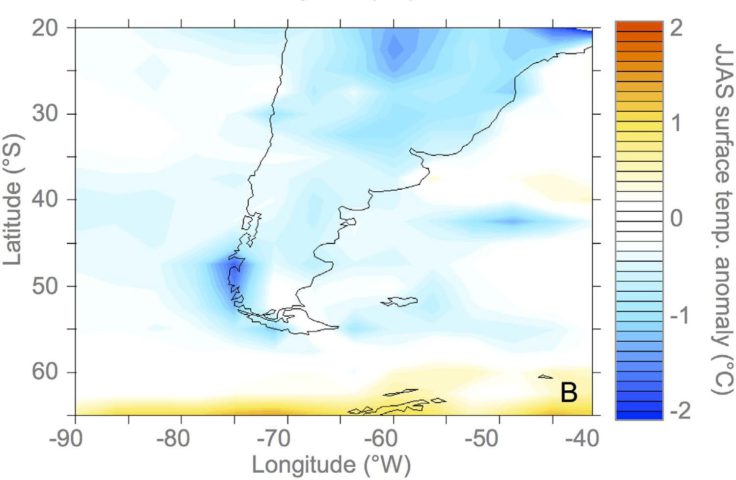NEWS STORY: Lake drainage affected climate
The catastrophic release of fresh water from a vast South American lake at the end of the last Ice Age was significant enough to change circulation in the Pacific Ocean according to research published in the journal Nature Scientific Reports.
The study, led by Professor Neil Glasser from Aberystwyth University, reveals that the lake, which was about one third the size of Wales, drained several times between 13,000 and 8,000 years ago, with devastating consequences.
At its high point the lake extended over 7,400km2, held 1500km3 of water and occupied a basin which now contains Lago General Carrera in Chile and Lago Buenos Aires in Argentina. Held back by a dam formed by a large ice sheet, the lake drained rapidly as the ice sheet shrank in size.
Max Holloway, from British Antarctic Survey (BAS), used a sophisticated climate model to simulate a big lake drainage event. He said:
“Although the event was not on the scale of what could occur if the Greenland or Antarctic ice sheets melt, on a regional scale we would see significant impacts on ocean circulation and climate if such an event were to happen again. The climate response is surprisingly sensitive to the location of the freshwater input determining whether the impact was felt north and in the Pacific or south around Cape Horn and into the South Atlantic.”

Professor Glasser said:
“This was a massive lake. When it drained, it released around 1150km3 of fresh water from the melting glaciers into the Atlantic and Pacific oceans – equivalent to around 600 million Olympic-sized swimming pools. This had a considerable impact on the Pacific Ocean circulation and regional climate at the time.
Much of the freshwater drained into the sea near Golfo Peñas, south of the Chilean capital Santiago. The fresh water would have sat on top of the salt water as it spread out so it affected the regional ocean currents. The event affected the whole of southern South America and would have led to lower rainfall in winter and cooler ocean and air temperatures around Cape Horn, with the effects felt as far east as the Falkland Islands.
The study is important because we are currently concerned about the volumes of fresh water entering the oceans from the melting ice sheets in Greenland and Antarctica and this gives us an indication of the likely effects.”
The study was undertaken by scientists from Aberystwyth, Exeter, Stockholm and Reading Universities and the British Antarctic Survey who applied different techniques to investigate the size of the former lake and how it drained.
Samples of sediments deposited by the former lake were collected to determine the age of the lake drainage events using a laboratory technique known as single-grain optically stimulated luminescence dating.
Digital Elevation Models (DEMs) were applied to identify former lake shorelines and their altitudes and drainage routes and to calculate the volume of water released as the lake drained. An ocean-atmosphere climate model was used to determine the impact of dumping this amount of freshwater into the Pacific Ocean.
The research was funded by the UK Natural Environment Research Council (NERC) with support from the Swedish Research Council.
The paper: Glacial lake drainage in Patagonia (13-8 kyr) and response of the adjacent Pacific Ocean by Neil F. Glasser (Aberystwyth University), Krister N. Jansson (Stockholm University), Geoffrey A. T. Duller (Aberystwyth University), Joy Singarayer (Reading University), Max Holloway (British Antarctic Survey) & Stephan Harrison (Exeter University) is available online at http://www.nature.com/articles/srep21064